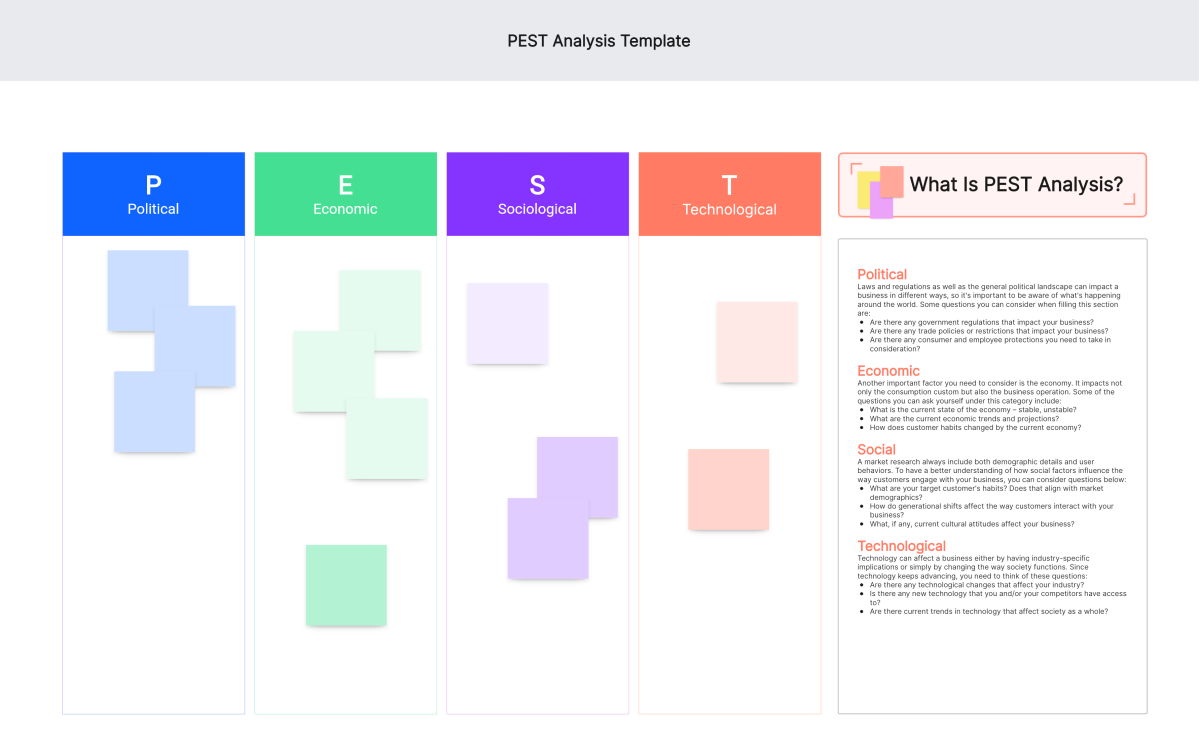In business strategy and market analysis, SWOT and PEST analyses are essential tools that help organizations understand their internal and external environments. Despite their similarities, these tools focus on different aspects and have distinct applications. This article provides an in-depth look at the differences and connections between SWOT and PEST analyses, aiding readers in better understanding and utilizing these tools.
What is SWOT Analysis?
SWOT stands for:
-Strengths: Competitive advantages of the project.
-Weaknesses: Internal disadvantages compared to competitors.
-Opportunities: External opportunities that can be leveraged.
-Threats: Potential issues that could negatively impact the project.
By analyzing these four aspects, you can identify internal strengths and weaknesses that may affect the project’s outcomes, as well as external factors that could influence its success or failure.

Boardmix allows you to quickly and easily create a SWOT analysis model. It offers a variety of creative tools for making professional charts, pre-made SWOT templates for fast application, and the ability to generate SWOT analyses with Boardmix AI for intelligent convenience.
What is PEST Analysis?
PEST stands for the analysis of external factors before starting a new project or conducting market research. These factors are:
-Political: Laws, regulations, and political issues that affect the project.
-Economic: Macro and microeconomic factors, including national income, GDP, consumer income levels, and employment rates.
-Social: Education levels, cultural values, religious beliefs, customs, and social attitudes.
-Technological: Innovation, technology acquisition, patents, manufacturing, research funding, and global communication.
Sometimes, PEST can be expanded to PESTLE, including:
-Legal: Proposed or enacted legislation.
-Environmental: Local or global environmental issues and their social and political contexts.

Unlike SWOT analysis, PEST analysis focuses directly on external macro-environmental factors that may influence the project and helps in understanding market growth or decline, as well as setting new project directions.
Boardmix offers standardized PEST analysis templates and numerous case studies to help you get started immediately. It also provides various creative elements like emojis and sticky notes for creating PEST analysis charts flexibly.
Differences Between SWOT and PEST Analyses
Scope of Analysis
-SWOT Analysis: Covers both internal (strengths and weaknesses) and external factors (opportunities and threats).
-PEST Analysis: Focuses solely on external macro-environmental factors, not internal organizational aspects.
Focus Areas
-SWOT Analysis: Aims to identify and evaluate internal and external factors to develop specific strategic actions.
-PEST Analysis: Aims to identify and evaluate macro-environmental factors to provide background information for strategic decisions.
Content Specificity
-SWOT Analysis: Comprehensive, including internal resources and capabilities, as well as external market and competition factors.
-PEST Analysis: Concentrates on macro-environmental factors without specific market or competition analysis.

Connections Between SWOT and PEST Analyses
Complementarity
PEST analysis provides the macro-environmental context that can serve as input for the external opportunities and threats in a SWOT analysis. For instance, political, economic, social, and technological factors identified through PEST can be evaluated further as external opportunities or threats in SWOT.
Combined Use
Organizations often use both SWOT and PEST analyses together in strategic planning. PEST helps identify critical external factors, while SWOT helps integrate these factors to formulate specific strategic measures.
Enhanced Decision-Making
By combining SWOT and PEST analyses, organizations can gain a comprehensive understanding of their internal and external environments, leading to more informed and effective strategic decisions. This combined approach helps maintain competitive advantage in a complex and changing environment.
Using the information above, you can effectively apply SWOT and PEST analyses for strategic planning. At this point, you can invite your team members to collaborate using Boardmix. Boardmix enables real-time online collaboration, video conferencing, discussions, and decision-making.

Advantages of Using Boardmix for Strategic Analysis
-Real-time Collaboration and Communication: Boardmix offers a shared online whiteboard for team members to collaborate and communicate in real-time, regardless of location.
-Rich Visualization Tools: Boardmix provides flowcharts, mind maps, timelines, and charts to help teams visualize and understand complex strategic analysis content.
-Diverse Templates and Easy Operation: With various strategic analysis templates, including lean canvas models, business model canvases, SWOT, and PEST analyses, Boardmix helps teams start quickly and easily.
-Fostering Team Innovation: Boardmix’s open whiteboard environment and collaborative tools encourage team members to express ideas and creativity freely.
-Flexibility and Convenience: As a cloud-based tool, Boardmix can be accessed on any device, allowing team members to edit content anytime, anywhere.













